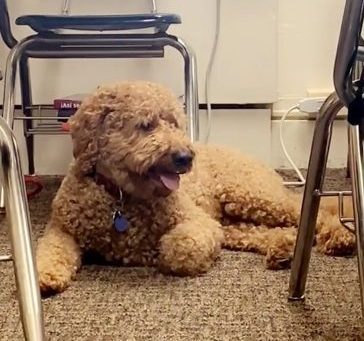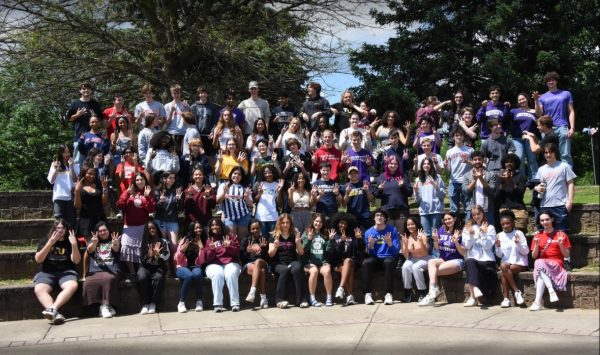The Importance of SSFS Dogs––and How We Can See Them in Quarantine

One of the pretty unique traits of the Upper School at SSFS, and one of the most universally appreciated joys of class, is the welcome presence of several teachers’ dogs in their classrooms. I remember seeing Tallulah stroll past my desk up to the front of the class when I shadowed a junior in Steff’s class during my 8th grade visit. Of course, I was ecstatic. It was another reason to look forward to high school here; how can I be bored in class when there’s a dog? To this day, the joy I feel when I walk into one of my classes to see that the dog’s been brought in is one of the highlights of my time here.
I’ve heard a variety of different forms of appreciation for the classroom dogs, from students begging teachers to bring them in for movie or test days, to drawings of the dogs, to more. Each Friday, middle-schoolers from the “Heart and Paw” committee would walk teachers’ dogs around campus each afternoon. A friend of mine with a dog allergy loved the ones in his class so much that he bought a backscratcher for each dog to “pet” them. Another friend, Moira McCudden, has told me about how having dogs in class helped her overcome a childhood fear of them. The love for our puppies hardly stops.
While never failing to make us happy, the dogs even help to bring focus or clarity, rather than distraction or chaos, to class. Cathy Harrison, who has been bringing her beloved Australian Shepherd, Riley, to school since she was a 7-week-old puppy, says that, “She brings a calm, or a sense of humor. She tends to read the mood of the class and will seek out students who need a smile.” As Moira concluded from a study she did for peer-counseling, she found that, “Having a dog present, especially to pet, can occupy a portion of an overwhelmed brain and allow for better focus. Think of a fidget toy, but soft and warm.” The presence of a dog provides companionship and kindness for students, creating a more positive and supportive learning environment.
Of course, in a time like the present, where in-person interaction is no longer an option, it may seem impossible to continue the relationship between students and our beloved canines. I, myself, found this to be one of my greatest disappointments in the closing of school. But over the course of the weeks of adjustment to the new structure, and the usage of Zoom, I’ve found that this relationship hasn’t gone away. Cathy still puts Riley on the camera, and Riley can hear our voices and know we’re there. The at-home environment even gives students an opportunity to bring their pets into the frame, bringing even more animal companionship to the class. Even in a time of confusion and change, we are still finding ways to preserve a feature of class at SSFS that really embodies the personal and supportive environment we try to cultivate.
So, in the next few weeks, I would encourage students to continue seeking out the kindness of our pets. Put your pets on Zoom. Ask your friends how their cat is doing, or if you can see pictures of their puppy. Look for the joy in animals that dogs have brought to SSFS. As Cathy put it, “[Riley] doesn’t ask for anything from the students. She is just there.” In a time of stress and expectations, we could all use that lack of judgement, full acceptance, and simple peace that pets bring to our lives.

Hi! My name is Irene Denniston and I'm an senior. This is my 14th year at SSFS, and my third year doing Wildezine. I've been doing creative writing, short...











Beatrix • Jun 5, 2020 at 12:05 pm
Animals have a natural talent to just calm me down – except for the wild ones (duh) – and I find it super interesting how they’ve been integrated into our school lives. I was really happy when I found out about the birds in the nurse’s office because I’ve always thought that it would be fun to have a wider variety of animals. The problem would be allergies, though, which makes me sad to think about. I would love someone to bring a cat, but then I’d just be miserable. Maybe we could substitute one of the Spirit Week days for an opportunity for kids to bring in their pets? It could be called Zoo Day.
Maybe we could substitute one of the Spirit Week days for an opportunity for kids to bring in their pets? It could be called Zoo Day.